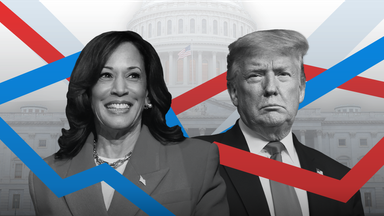Who is favourite to win the US election? Follow the latest polls and play our game to predict who you think will win
Maps and charts explain how the US election works and who is likely to win, according to current national and state polling and the latest betting odds.

The presidential election on 5 November is set to be the tightest race since at least 2000.
Kamala Harris currently holds a slender lead over Donald Trump, according to the latest polls.
But the US election is not all about who wins the most votes overall, it’s about who wins in the right states.
How does the US election work?
If we add up the votes in “safe” states that the candidates probably don’t need to worry about so much, Harris is on 225 electoral college votes and Trump on 219, in their race to 270.
Of the 94 votes left in the eight crucial swing states where the races are tight, Harris needs 45 to win the presidency and Trump needs 51.
Harris is currently leading in all of those.
You can watch live coverage of the debate between Kamala Harris and Donald Trump from midnight tonight on Sky News, on web and on mobile
But Harris’s leads are narrow. All it takes is for Trump to turn fortunes around in Pennsylvania (19 votes), North Carolina (16) and Georgia (16) and he will reach exactly the 51 he needs to win.
Despite being behind in the polls, Trump is the bookies’ favourite, reflecting a belief among punters that there’s a lot of movement to look out for in the remaining weeks of the campaign.
Predict who you think will win in each swing state and we’ll tell you who the president will be if you’re right.
Swing states
We can already be fairly confident of the result in lots of states. California and New York for example have voted Democrat at every election for the past 30 years.
Texas is the same the other way around – they haven’t voted for a Democrat since Jimmy Carter in 1976, almost 50 years ago. Only five states changed hands in 2020.
That’s why those eight states that could go either way are so very important.
If Trump doesn’t win in Pennsylvania, his route to victory becomes increasingly narrow – he would need to win at least four of the six biggest remaining states.
If he does win there, however, he can become president with just two others.
There is no recent polling in Nebraska’s second district by pollsters recognised by our US partners NBC News, but that single electoral vote could make all the difference if other states go a certain way.
If Trump wins Pennsylvania, Georgia and Michigan and loses North Carolina, Arizona, Wisconsin and Nevada, he would be stuck on 269 – Nebraska 2nd would take him over the line.
What happens if it’s a tie in the electoral college?
Each of the fifty states, plus Washington DC, holds their own vote for president which is independent from the others.
Each state is worth an amount of “electoral college votes” – effectively points – related to the population of the state.
California, the most populous US state, has 54 electoral college votes representing their 39 million population.
Wyoming, the smallest US state, has three electoral college votes representing their 600,000 population.
There are 538 “points” in total. To become president, a candidate must get to 270 (more than half). It doesn’t matter what combination of states gets them there, but some routes are easier than others.
In most states – all except Nebraska and Maine – the winning candidate in a state gets all of the electoral votes available.
So if Donald Trump was to win Florida by a single vote, he would get all 30 of their electoral college votes, the same as if he got 100% of the popular vote there.
In Nebraska, two votes are allocated to who wins the state overall, and one each to the candidate who wins in three districts of Nebraska – making five overall. It’s the same in Maine but there are only four electoral college votes up for grabs there, so its other votes are split across two districts rather than three.
Who is the bookies’ favourite?
We’ve mostly spoken about the polls so far, but there’s another often overlooked way to gauge the potential outcome of the election – by looking at where people are putting their money.
Betting markets, unlike polls, are driven by people willing to back their predictions with real money. This means they reflect not just today’s opinions but also the collective wisdom of people who are invested in the outcome about how things might change going forward.
Sky News is tracking the odds of Kamala Harris and Donald Trump winning the 2024 election. We’ve translated the odds into percentages to reflect the implied probability of each candidate’s victory.
The percentage refers to the candidates’ overall chance of winning, by whatever margin, not an implied vote share or electoral college split.
Who is the people’s favourite?
Sometimes it’s not about policy but just about whether you like one candidate more than another.
Americans are more likely to find Donald Trump unfavourable than favourable, but he has had a recent (relative) jump in popularity.
It’s the reverse for Harris at the moment – she had a brief bounce after becoming the official candidate, but has since dropped to a level close to Trump’s new high.
As the election approaches, keep an eye on all these trackers to see the polls and betting markets’ predictions evolve, and what they reveal about where the race to become president is going.
The Data and Forensics team is a multi-skilled unit dedicated to providing transparent journalism from Sky News. We gather, analyse and visualise data to tell data-driven stories. We combine traditional reporting skills with advanced analysis of satellite images, social media and other open source information. Through multimedia storytelling, we aim to better explain the world while also showing how our journalism is done.



